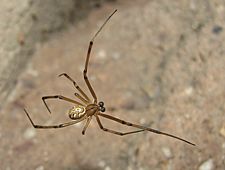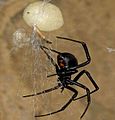Western black widow spider facts for kids
Quick facts for kids Western black widow spider |
|
|---|---|
 |
|
| Latrodectus hesperus female | |
| Scientific classification | |
| Genus: |
Latrodectus
|
| Species: |
hesperus
|
Latrodectus hesperus, the western black widow spider or western widow, is a venomous spider species found in western regions of North America. The female's body is 14–16 mm (1/2 in) in length and is black, often with an hourglass-shaped red mark on the lower abdomen. This "hourglass" mark can be yellow, and on rare occasions, white. The male of the species is around half this length and generally a tan color with lighter striping on the abdomen. The population was previously described as a subspecies of Latrodectus mactans and it is closely related to the northern species Latrodectus variolus. The species, as with others of the genus, build irregular or "messy" webs: unlike the spiral webs or the tunnel-shaped webs of other spiders, the strands of a Latrodectus web have no apparent organization.
Female black widows have potent venom containing a neurotoxin active against a range of mammals (see latrodectism). In humans, symptoms to this venom include pain, nausea, goosebumps, and localized sweating. In historical literature, fatalities were reported at anywhere between 0.5% and 12%, but studies within the past several decades have been unable to confirm any fatalities from this or any of the other U.S. species of Latrodectus (e.g. zero fatalities among 23,409 documented Latrodectus bites from 2000 through 2008). The female sometimes may eat the male after courtship. Male western widows may breed several times during their relatively short lifespans. Males are known to show preference for mating with well-fed females over starved ones, taking cues from the females' webs.
Contents
Range
Latrodectus hesperus can be found in western regions of North America. In Canada it can be found from British Columbia to Manitoba. They are most commonly found near the Canada-US border, as well less commonly throughout prairies regions of the Canadian Prairies in Western Canada.
Mating behavior
The female is stimulated upon contact of a male's web, and vice versa. In many instances, the female will not accept the courtship and will scare the male away.
One strategy performed by the male L. hesperus to ensure a successful courtship with the female is to minimize the escape route options for the female within her own web. This is accomplished by the male severing the female's web at various locations that the male believes could provide the female with a course of action to avoid the male. Once the male has successfully made contact with the females’ body, he creates what is known as the “bridal veil”, which is simply silk thrown onto the female.
The time spent on courting varies tremendously and can be as short as ten minutes or as long as two hours.
Hunting and diet

Hunting
L. hesperus frequently hangs upside down near center of the web and waits for any insects to enter the web to attack. It bites its victim then wraps it in silk. There are multiple aspects of this spider's web that serve the purpose of capturing prey. The web incorporates hanging gum-footed threads that have liquid glue on them. When prey come into contact with these threads, they get stuck to them, causing the thread to break and the prey to be propelled up by the web to an easy point of access for the spider. The web of L. hesperus also allows for locomotive action by the spider when attacking prey through a sheet of silk. In the months of May through October, there is a significant increase in the amount of prey caught by L. hesperus, presumably because these are the months in which the female produces her egg sacs, and in which the offspring are born and their survival is dependent on their mother's ability to feed them.
Prey cues
L. hesperus follows prey cues when determining where to settle down. The female L. hesperus is able to detect chemical cues from their prey. As a by-product of this detection, L. hesperus is more likely to build a home in an area that is expressing a high degree of chemical prey cues. This finding may grant us the ability of controlling L. hesperus infestations. By killing off the prey of L. hesperus, there will be a correlated side-effect that pushes L. hesperus to relocate to a location where there are more available prey.
Diet
Like other web-building spiders, L. hesperus are polyphagous and feed on prey from eight different arthropod orders. In one study in British Columbia, the orders Coleoptera and Hymenoptera accounted for the majority of the spiders' prey; the majority of prey within Coleoptera were darkling beetles, weevils, and ground beetles, and the most common Hymenoptera were ants, wasps, and bumblebees. The peak activity of hymenopterans in this study was May through September in British Columbia, paralleling a spike in consumption by L. hesperus during these months.
L. hesperus may feed on its own species under three circumstances: when alternative prey options are scarce; when a spider is starving; in self-defense during antagonistic bouts.
Webs and silks
Silks
The silk produced by L. Hesperus is strongly adhesive. The silk has a fiber at the center covered by some droplets of liquid adhesive protein. When rubbing against one's fingers, it feels like the texture of rubber. The droplets are about twenty times larger than the center fiber's diameter and are visible to the naked eye.
The ultimate strength and other physical properties of L. hesperus silk were found to be similar to the properties of silk from orb-weaving spiders. The ultimate strength for the three kinds of silk measured in the study was about 1000 MPa. The ultimate strength reported in a previous study for Trichonephila edulis was 1290±160 MPa (The ultimate strength of mild steel is about 800 MPa.)
L. hesperus produces three different types of silk: dragline silk, inner egg case silk, and scaffolding silk. Analysis of the amino acid composition of the various silks produced by L. hesperus show that both dragline silk and scaffolding silk are primarily composed of alanine and glycine, in fact neither cysteine nor methionine were detected at all in these silks. In the inner egg case silk, although alanine remained an abundant amino acid, its abundance was less so in this silk than the others.
L. hesperus' silk contains sexual pheromones which are perceived by the opposite sex upon contact with the web. The males are able to locate the female and begin courting behavior in response to female pheromones. The female curtails her predatory reflexes against the male in response to male pheromones.
Web architecture
L. hesperus produces cobwebs. Cobwebs differ from orb webs, and their architecture can be broken down into three sections. Two sections are utilized to capture prey, the gumfoot threads and the mesh region. The third section provides the structural support for the web and is known as the scaffold threads. The gumfoot lines hang beneath the web, the liquid glue on these lines serves as a sticky substance to trap prey in. The line will break once prey catches on it, creating a tensile force within the web that pulls the line along with the prey up to the spider. L. hesperus seeks refuge in the location from which the web originates and emerges.
Web behavior
L. hesperus reacts to changes in prey capture by altering its web-spinning behavior. When the spider reaches satiety, it will decrease its energy expenditure on building the features of the web specifically purposed for prey capture. This is evolutionarily advantageous for the spider because it is already satiated. Therefore, it would be a waste of energy to seek out more nutrients. Although there is a decrease in prey-capturing aspects of the web, the overall silk production remains steady or in some cases will increase. L. hesperus also decrease silk investment into webs when preparing for offspring by alternatively increasing silk investment into egg sac production.
Defensive behavior
The black widow spiders face some predators, like mice, which are omnivorous and larger than the black widow. Juveniles and female adult L. hesperus can eject a chunk of viscid silk toward potential predators. This silk is not toxic, but its mechanical irritation can thwart most predators. However, adult males are unable to produce this defensive silk, presumably because they need to conserve energy for reproduction during their relatively short life span. However, this defensive behavior is very important to females, which are under heavy predation pressure. Black widow spiders will spend lots of time on web construction during late night, which is also an activity time for ground mice. If the webs are low above ground, it is easy for mice and other predators to attack from below. Since the spider will stay largely stationary at the web hub, such an attack can be mostly successful if there is no defensive behavior.
Venom
L. hesperus’ bite is similar to that of the black widow because of their relatedness. The venom is exuded from the spiders' fangs and injected into the enemy. The spiders' prey is paralyzed by the venom, which enables their future digestion. For humans, the venom behaves like a neurotoxin, affecting the hormone acetylcholine. The female is more of a threat than the male in this species, however her aggressive side only comes out when she is protecting her eggs.Not only are the females fangs larger than the males, but their venomous glands are also more distinct. The effects of their bite can range from a simple irritation to severe autonomic disparities. The venom is composed of proteins, peptides, and proteases. The venom causes an excess release of neurotransmitters which can cause a slew of symptoms. Some of these symptoms include muscle rigidity, perspiration, and nausea. Treatments include painkillers and antivenom if the toxicity is severe enough.
Gallery
See also
 In Spanish: Viuda negra norteamericana occidental para niños
In Spanish: Viuda negra norteamericana occidental para niños












